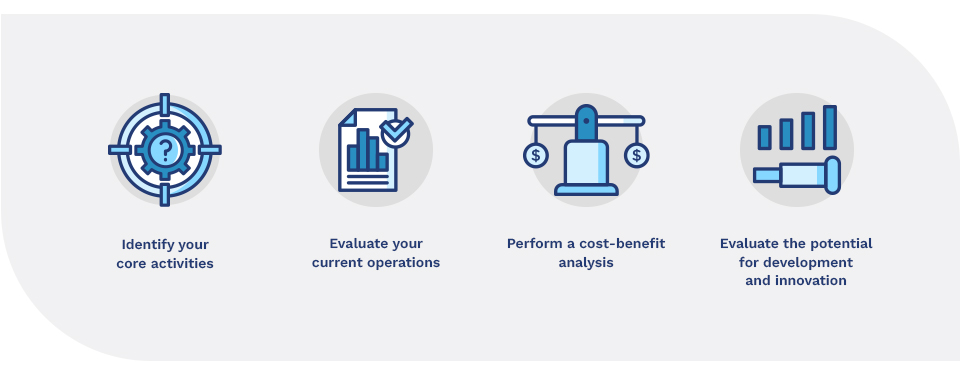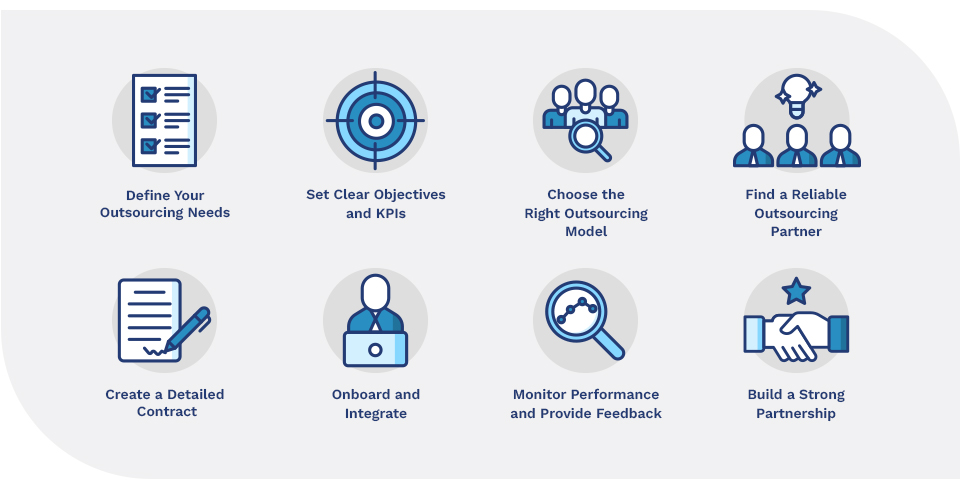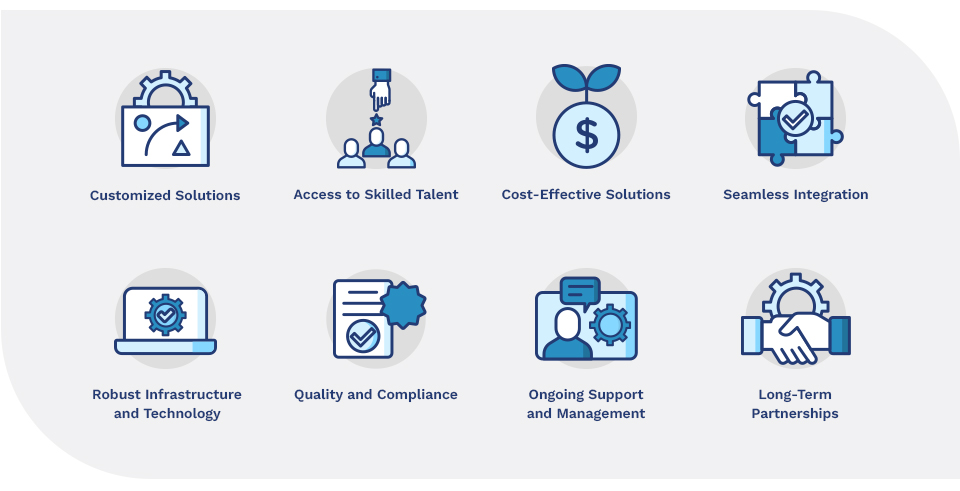Over the years, outsourcing has changed from a way to cut costs to a way for businesses of all kinds to grow. Outsourcing can be a very important choice for startups in fast-paced markets like Australia and the US. It gives you access to specific knowledge, lowers costs, and lets you focus on what you do best. It’s a strategic step that enables organizations to quickly scale, increase competitiveness, and attain long-term success.
But is this solution the one your business needs? When should your business outsource? Deciding if and when to take this step is very important. In this article, we cover just that and provide actionable insights on when and how to leverage outsourcing to allow your team to focus on what truly matters: driving your company forward.
What Is Outsourcing? A Brief Overview
Outsourcing is like hiring extra helpers for your business. Instead of doing everything yourself, you can ask other companies to take care of specific tasks. This could be anything from fixing computer problems to finding new customers or answering phone calls.
For small businesses just starting, outsourcing can be a big help. It can save you money, let you focus on what you do best, and even help you grow faster.
But how do you know when it’s the right time to get help? This article will help you figure out if outsourcing is a good idea for your business.

Is Outsourcing Right for You? How to Decide for Your Business
Recognizing the indications that your company is ready to outsource is vital for making sound decisions. Let us look deeper into these signs.
Is your team feeling overwhelmed?
Are your staff working late? Do they make more mistakes than usual? When your team is stressed and overworked, it can lead to burnout, decreased productivity, and even job resignations. When your workforce is frequently overworked and unable to fulfill deadlines, consider outsourcing.
Is your business making too many mistakes?
A lack of in-house competence in key areas might impede business growth and efficiency. If your consumers are dissatisfied with your job, it could be because your crew is too busy. When people are rushed, they are more likely to make mistakes. This can ruin your reputation and cost you consumers.
Can’t make deadlines?
Are you constantly behind schedule? Missing deadlines might make your firm appear untrustworthy. Customers and clients want things to be completed on schedule. If you find yourself struggling to keep up, it may be time to seek assistance.
Does your company lack any vital skills?
Does your team have all of the necessary skills to execute their jobs? Sometimes you’ll require specialized knowledge or experience that no one on your team has. This can slow down your business.
Determining What Tasks to Outsource
Outsourcing solutions can improve efficiency, cut costs, and focus on key skills. However, choosing which activities to outsource is critical. Here are steps to find out:

Identify your core activities
Determining which tasks are critical to your company’s performance is the first step toward successful outsourcing. These key activities are the vital functions that propel your company’s growth and competitive edge. You may make the most of your abilities and resources by concentrating on these fundamental capabilities.
Evaluate your current operations
Determine which tasks are time-consuming, inefficient, or costly. These domains may be ideal candidates for outsourcing. You can streamline your operations and increase overall efficiency by identifying bottlenecks and areas where external knowledge can provide value.
Perform a cost-benefit analysis
Compare the internal expenses of doing things in-house to the potential savings outsourcing provides. Include labor, overhead, and equipment expenditures. Outsourcing may be a profitable investment if it dramatically reduces expenses or increases efficiency.
Evaluate the potential for development and innovation
Outsourcing can free up internal resources, allowing your team to prioritize strategic objectives and innovation. Delegating non-core responsibilities enables you to make room for growth and development.
Steps to Start Outsourcing
Now that you have determined the tasks you may want to outsource, here are some steps to maximize its benefits:

1. Define Your Outsourcing Needs
Identify tasks or processes that can be outsourced without compromising core competencies. Assess the required skills and workload for each identified area.
2. Set Clear Objectives and KPIs
Establish specific goals for outsourcing, such as cost reduction, improved efficiency, or access to specialized skills. Define key performance indicators (KPIs) to measure success.
3. Choose the Right Outsourcing Model
Select the most suitable outsourcing model based on factors like location, control requirements, and budget. Consider onshore, nearshore, or offshore options, as well as dedicated teams or project-based arrangements.
4. Find a Reliable Outsourcing Partner
Conduct thorough research to identify potential partners with the necessary expertise and a strong track record. Evaluate their reputation, security measures, and alignment with your company culture.
5. Create a Detailed Contract
Develop a comprehensive contract outlining the scope of work, deliverables, timelines, pricing, and performance expectations. Include clear service level agreements (SLAs) and provisions for dispute resolution.
6. Onboard and Integrate
Provide the outsourced team with the necessary information, training, and support to ensure a smooth transition. Establish effective communication channels and integrate them into your workflow.
7. Monitor Performance and Provide Feedback
Regularly assess the outsourced team’s performance against agreed-upon KPIs. Provide constructive feedback and make necessary adjustments to optimize results.
8. Build a Strong Partnership
Foster open communication, trust, and collaboration with your outsourcing partner. Recognize and reward their contributions to build a long-term relationship.
By following these steps and maintaining a strategic approach, you can harness the full potential of outsourcing to achieve your business goals.
Knowing when to outsource can greatly affect your business’s efficiency and growth. Outsourcing can help when internal teams are overburdened, deadlines are missed, or your organization lacks capabilities. Outsourcing lets you streamline operations, cut expenses, and focus on core competencies by identifying non-essential jobs, assessing company needs, and choosing a suitable partner like Big Outsource, that will help boost innovation and scalability of your business with careful planning and strategy, assuring long-term success.
Big Outsource: Your Partner for Success
Aside from offering a comprehensive range of outsourcing services, Big Outsource also helps build a long-term partnership for companies seeking to enhance their operations and achieve strategic objectives. We offer:

- Customized Solutions: Tailored solutions to meet specific business requirements.
- Access to Skilled Talent: Access to a pool of highly qualified professionals.
- Cost-Effective Solutions: Competitive pricing and optimized operational efficiency.
- Seamless Integration: Streamlined onboarding and integration processes.
- Robust Infrastructure and Technology: State-of-the-art tools and systems for efficient operations.
- Quality and Compliance: Adherence to high standards and regulatory requirements.
- Ongoing Support and Management: Dedicated account managers and continuous monitoring for optimal performance.
- Long-Term Partnerships: Building strong and enduring relationships with clients.
By leveraging Big Outsource’s expertise and services, businesses can unlock the potential of outsourcing to drive growth, improve efficiency, and achieve their strategic goals.
Outsourcing solutions can relieve the pressure of mounting unresolved tasks and missed deadlines. It is also a way to give your team the space to innovate and drive growth.
Schedule a consultation with us to maximize the benefits of this staffing solution and enhance your business.


